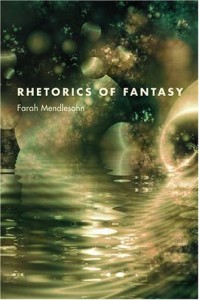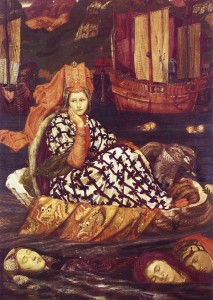 When John Clute and John Grant’s Encyclopedia of Fantasy first came out, I was excited about having some more academic and concrete terminology to use when teaching fantasy, and indeed I’ve referred to EoF quite often in class. The terminology, however, is often so specific that it requires sometimes no small amount of explanation, and terminology doesn’t necessarily mean a clear lens through which to interrogate a text. So when I heard that Farah Mendlesohn was coming out this year with a new “critical tool kit” (to use her words) for examining, reading, and thinking about fantasy, I was definitely looking forward to diving in to Rhetorics of Fantasy (Wesleyan UP, 2008) and coming up with new ways of thinking about and teaching fantasy.
When John Clute and John Grant’s Encyclopedia of Fantasy first came out, I was excited about having some more academic and concrete terminology to use when teaching fantasy, and indeed I’ve referred to EoF quite often in class. The terminology, however, is often so specific that it requires sometimes no small amount of explanation, and terminology doesn’t necessarily mean a clear lens through which to interrogate a text. So when I heard that Farah Mendlesohn was coming out this year with a new “critical tool kit” (to use her words) for examining, reading, and thinking about fantasy, I was definitely looking forward to diving in to Rhetorics of Fantasy (Wesleyan UP, 2008) and coming up with new ways of thinking about and teaching fantasy.
Mendlesohn’s approach to fantasy is in terms of classification; she’s posited four distinct types of fantasy, based on observation, and examines what constitutes these types: the portal/quest fantasy, immersive fantasy, intrusion fantasy, and liminal fantasy. I’ve written very little portal/quest or immersive fantasy lately, and I don’t think I’d be any good at liminal fantasy (which depends on irony and equipoise, and I think I have a tendency towards the literal, which makes irony difficult), so I was particularly interested in what she had to say about intrusion fantasy, as well as magic realism (which she contains under immersive fantasy).
To begin with magic realism, I’ve always felt like it was a larger category than some critics allow. The most specific definition of magic realism—and the one which Mendlesohn seems to draw from—is that it’s a literature written almost exclusively by Latin or South American writers. Mendlesohn notes that there is discussion as to whether it’s possible to have magic realism in English, and certainly William Harmon and Hugh Holman’s A Handbook to Literature (9th ed; Prentice Hall, 2003) is inclined in that direction, defining “The frame or surface of the [magic realist] work may be conventionally realistic, but contrasting elements—such as the supernatural, myth, dream, fantasy—invade the realism and change the whole basis of the art” (297). I subscribe to this broader definition of magic realism, although I will admit that I haven’t read much in English that does exactly what Borges and García Márquez do (I think Angela Carter, for example, comes close to making the real unreal and the unreal real). What I found to be most fascinating in Mendlesohn’s discussion here, however, has to do with her analysis of Southern literature as perhaps the most likely candidate for an English-language equivalent of magic realism, which reminded me of something a colleague (who came to the South from the North) once told me: when she taught Flannery O’Connor to her Northern students, they thought the stories were surrealism; but when she came to the South her students took O’Connor as outright mimesis. Someone (maybe O’Connor?) said something to the effect that, unlike in other regions of the country, in the South we don’t lock up our freaks in the attic but parade them down Main Street; in other words, we live with and accept our legitimate strangeness. How does this connect to my writing? Having lived in the South for most of my life, I’ve had the opposite reaction to my environment than most Southern writers in that I don’t set a lot of my stories in this region. To be honest, I’m not a fan of the geography or the humidity or the summer temperature or the days-on-end of perfect skies. But Mendlesohn’s suggestion of Southern literature as magic realism has really intrigued me. I haven’t written anything yet I’d consider particularly magic realist, but I’d like to, so now I have a new idea to mull over.
Likewise, Mendlesohn’s discussion of intrusion fantasy also makes me think about old things in new ways. A lot of what I write falls into the category of intrusion fantasy, in which Mendlesohn says “…the world is ruptured by the intrusion, which disrupts normality, and has to be negotiated with or defeated, sent back whence it came, or controlled” (115). I like the control of this definition; it renders succinctly the main sense of this type of fantasy. The protagonist(s) might be surprised or amazed or unnerved by the intrusion of the fantastic—a main difference, I would agree, between intrusion fantasy and magic realism—but eventually comes to accept it. But how long is too long for that acceptance to take hold? As Mendlesohn points out, “At least one of the necessary considerations for writers constructing intrusion fantasies is how to negotiate this acceptance” (115), and she offers several examples of different lengths of time, from relatively early on in the narrative until close to the end. I also found it useful to think about Mendlesohn’s notion that “The rhythm of the intrusion fantasy is a cycle of suspension and release, latency and escalation, hesitation and remorselessness” (115). Things get ratcheted up, then get eased back, ratcheted up, eased back, and so on and so on. Since I’m concerned about constructing plots, thinking about how to incorporate this sense of rhythm into my work is useful. Also intriguing is that Mendlesohn notes “how important sexuality and intimacy is to the intrusion fantasy, but we have also seen that latency is constructed in part through a holding back, a denial of sexuality—and of the truth of relationships between the protagonists” (176), following a discussion of “The metaphorization of seduction, rape, and colonization” (175). If you’re a good Freudian, the name “intrusion fantasy” automatically suggests this kind of sexual metaphor, especially coupled with language like “release” and “escalation.”
Overall, as an academic I found Rhetorics of Fantasy to be both an entertaining and a useful read; I’ll certainly rely on Mendlesohn’s taxonomy the next time I teach a fantasy literature course. However, a danger for the creative writer—or for this writer, anyway—lies in becoming too stymied by literary criticism, or becoming too concerned with creating a “meaning” in the writing to actually create. Sometimes it’s difficult to turn off the voice of the literary critic in my head.





